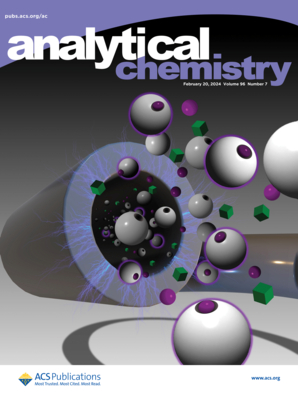串联质谱法中加合物诱导的变异。
IF 6.7
1区 化学
Q1 CHEMISTRY, ANALYTICAL
引用次数: 0
摘要
串联质谱(MS/MS)提供了基本的结构信息,在代谢组学的化合物注释中起着核心作用。虽然预计不同的前体离子类型会影响MS/MS谱的生成,但对前体离子类型相关的MS/MS变异性的系统研究有限。为了解决这一差距,我们分析了来自NIST 20光谱库的24,686种独特化合物的50多万MS/MS光谱,涵盖了广泛的前体离子类型和碰撞能量(CEs)。利用[M + H]+和[M - H]-光谱作为参考,我们发现碱阳离子加合物如[M + Na]+和[M + K]+表现出明显的断裂行为和较低的光谱相似性,这可能是由于碱电荷载体的不同性质,它们不促进质子化的断裂途径,而是通过配位稳定前体离子。相比之下,[M + NH4]+, [2M + H]+, [M + H - H2O]+, [M + Cl]-, [2M - H]-和[M - H - H2O]-表现出中等到高度的相似性,因为它们经常经历中性损失,产生[M + H]+或[M - H]-,或者它们本身就是由这些离子衍生的。我们的研究还发现,在较低的CE下,破碎是由结构驱动的,而在较高的CE下,破碎是由能量驱动的。这种模式允许在高CE下不同前体离子类型之间具有更高的光谱相似性。然而,[2M + H]+或[2M - H]-在较高的CE下表现出较低的相似性,这可能是因为在这些较大的前体离子中,相同数量的能量分布在更多的键上,导致每个键的能量较少。最后,我们证明了忽略前体离子类型会损害化合物注释,包括光谱库搜索、分子网络和机器学习模型开发。总的来说,本研究强调了前体离子类型对MS/MS谱的关键影响,并强调了代谢物注释中前体离子类型感知策略的必要性,这在代谢组学领域很大程度上被忽视了。本文章由计算机程序翻译,如有差异,请以英文原文为准。
Adduct-Induced Variability in Tandem Mass Spectrometry.
Tandem mass spectrometry (MS/MS) provides essential structural information and plays a central role in compound annotation in metabolomics. While different precursor ion types are expected to influence the generation of MS/MS spectra, systematic investigations into precursor ion type-dependent MS/MS variability have been limited. To address this gap, we analyzed over half a million MS/MS spectra of 24,686 unique compounds from the NIST 20 spectral library, covering a broad range of precursor ion types and collision energies (CEs). Using [M + H]+ and [M - H]- spectra as references, we found that alkali cation adducted species such as [M + Na]+ and [M + K]+ exhibited distinct fragmentation behavior and low spectral similarity, likely due to the distinct nature of the alkali charge carriers, which do not promote protonated fragmentation pathways but instead stabilize the precursor ion through coordination. In contrast, [M + NH4]+, [2M + H]+, [M + H - H2O]+, [M + Cl]-, [2M - H]-, and [M - H - H2O]- showed moderate to high similarity to their references, as they often undergo neutral losses that generate [M + H]+ or [M - H]-, or are themselves derived from these ions. Our study also observed that fragmentation is structure-driven at lower CE and energy-driven at higher CE. This pattern allows for a higher spectral similarity among different precursor ion types at high CE. However, [2M + H]+ or [2M - H]- showed reduced similarity at higher CE, likely because the same amount of energy is distributed across more bonds in these larger precursor ions, resulting in less energy per bond. Finally, we demonstrated that ignoring precursor ion types can compromise compound annotation, including spectral library searches, molecular networking, and machine learning model development. Overall, this study underscores the critical influence of precursor ion types on MS/MS spectra and highlights the need for precursor-ion-type-aware strategies in metabolite annotation, which has been largely overlooked in the metabolomics field.
求助全文
通过发布文献求助,成功后即可免费获取论文全文。
去求助
来源期刊

Analytical Chemistry
化学-分析化学
CiteScore
12.10
自引率
12.20%
发文量
1949
审稿时长
1.4 months
期刊介绍:
Analytical Chemistry, a peer-reviewed research journal, focuses on disseminating new and original knowledge across all branches of analytical chemistry. Fundamental articles may explore general principles of chemical measurement science and need not directly address existing or potential analytical methodology. They can be entirely theoretical or report experimental results. Contributions may cover various phases of analytical operations, including sampling, bioanalysis, electrochemistry, mass spectrometry, microscale and nanoscale systems, environmental analysis, separations, spectroscopy, chemical reactions and selectivity, instrumentation, imaging, surface analysis, and data processing. Papers discussing known analytical methods should present a significant, original application of the method, a notable improvement, or results on an important analyte.
 求助内容:
求助内容: 应助结果提醒方式:
应助结果提醒方式:


